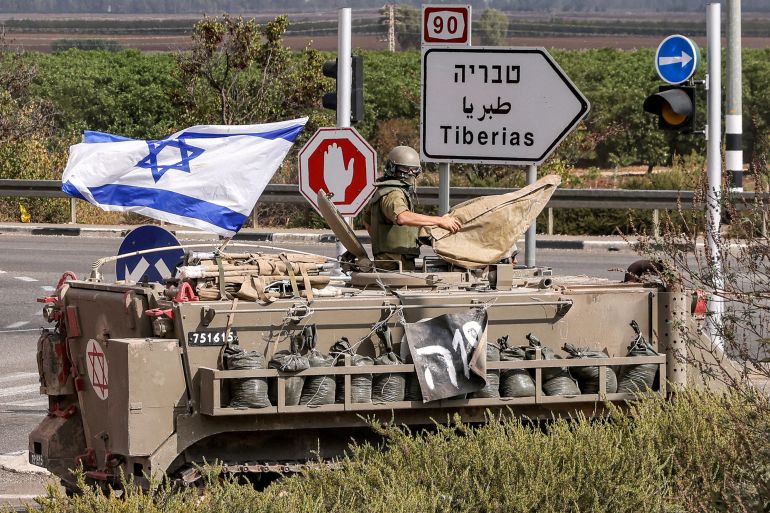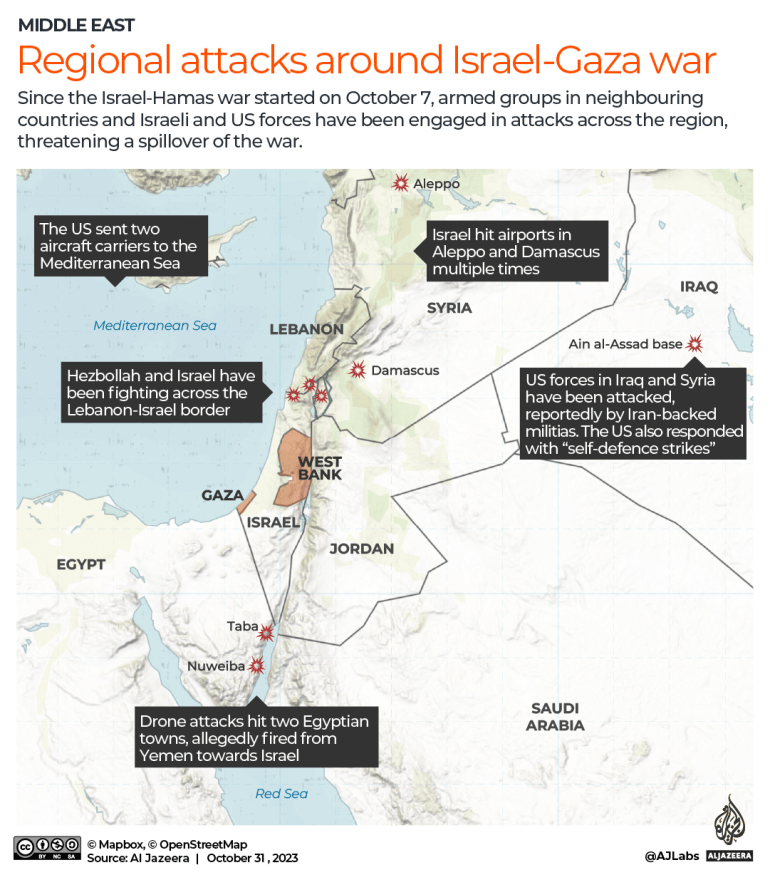Is the trajectory of Lebanon-Israel border conflict changing?
An upcoming Hassan Nasrallah speech on Friday could provide a better idea of Hezbollah’s plans for dealing with Israel.

Israel and Lebanon’s Hezbollah have been engaged in limited clashes at their borders for weeks, and things appear to be gradually escalating as Tel Aviv continues with its brutal military offensive in Gaza amid the rising human cost of the war.
Hezbollah fighters have exchanged fire with Israeli forces regularly since Israel launched its bombardment in the wake of the October 7 surprise Hamas attack that killed about 1,400 people in Israel. More than 8,500 Palestinians, mostly women and children, have been killed in non-stop Israeli bombardments, triggering protests across the world.
Keep reading
list of 4 itemsCyprus braces for refugee arrivals amid Lebanon war fears
Israel strikes Syria, Lebanon following rocket attacks, military says
Reuters, Al Jazeera journalists ‘targeted’ in Lebanon strike: Press group
So, what’s the latest on the border fighting between Israel and Hezbollah, how are things looking for Hezbollah at home and on the ground, what’s the Iran connection, and what comes next?
How big is the border fighting?
The scope of the border fighting has gradually increased over the weeks, but it has not turned into an all-out war yet.
At first, the two sides started hitting each other with artillery strikes, and Israel also brought in its drones.
In one of the earliest incidents of casualties, Reuters video journalist Issam Abdallah, 37, was killed in an Israeli attack that left several other journalists injured as well. Reporters Without Borders (RSF) said on Monday the attack was deliberate.
The exact number of casualties since then is unclear, but dozens are believed to have been killed, mostly Hezbollah members. The Israeli army has also reported several casualties, and a number of civilians have been killed.
Changing tactics?
Skirmishes between Israel and Hezbollah were mostly limited in scope and geography during the first three weeks of the border fighting, largely targeting isolated areas and military instalments close to the border.
But in the past few days, both sides have increased the scope of their operations, going beyond the 2-4km (1.2 to 2.5-mile) range from the border that they had previously observed.
Reporting from Lebanon, Al Jazeera’s Ali Hashem said on Monday that Israel is now seen targeting towns some 16km (10 miles) deep inside southern Lebanon, with Hezbollah and its backed armed groups hitting targets 14km (8.7 miles) deep. He said a residential building was also hit in Israel.
The Lebanese front, what's happening?
I can confidently say we're now in the third phase of the escalation.
1- depth of hostilities on both sides of the border is extended to at least 10 kilometers.— Ali Hashem علي هاشم (@alihashem_tv) October 30, 2023
Notably, Hezbollah has been tapping into its arsenal more. It has deployed more drones, used different types of antitank guided missiles, and just a few days ago started using surface-to-air missiles, one of which it said downed an Israeli drone.
Reporting from Rmeiche in southern Lebanon, Al Jazeera’s Zeina Khodr said the trajectory of the conflict is changing.
“The tactics being used by Hezbollah are evolving,” she said.
“During the first three weeks of the escalation, Hezbollah suffered a high number of casualties. Since Friday, it has only announced the deaths of two fighters. It is not clear whether this change in tactics aims to avoid heavy casualties or if it represents an escalation in the conflict.”
Will Hezbollah go all in?
Hezbollah commands a strong military wing, which is believed to be much more superior to the Lebanese army. But it does have to contend with local politics as well.
Last week, the country’s caretaker Prime Minister Najib Mikati said he is doing his duty to prevent Lebanon from entering the war.
“For now, Hezbollah has managed the situation rationally and wisely, and the rules of the game have remained constrained to certain limits,” he said.
Meanwhile, Lebanon is facing an acute economic crisis that has only gotten worse with the start of the war, while its politicians have failed to elect a president for a year.
So, even as many Lebanese may feel for Palestinians, they also fear getting entangled in a new war. That is especially true as many of them have experienced the bloody war with Israel in 2006, in which more than 1,200 people were killed in Lebanon, many of them civilians. At least 165 Israelis were also killed in the war.
But senior Hezbollah officials have been sitting down with top Hamas officials in Lebanon since the start of the conflict to discuss “all-out victory” over Israel.
The group’s secretary-general, Hassan Nasrallah, has been teasing an expected speech on Friday with short clips online, building up expectations for what he may announce and its effect on the fighting.
Sam Heller, a Beirut-based analyst with the Century Foundation think tank, said it is likely Hezbollah will escalate its attacks on Israeli positions or more fully enter the conflict now that Israel has launched its ground operations into Gaza.
“Domestic opposition to a destructive war would be substantial, but at the same time, my take is that it would not be enough to entirely constrain or deter Hezbollah from acting if its intervention is of sufficient importance for itself and the broader resistance axis of which it is a key part,” Heller told Al Jazeera.
In addition to Hezbollah and its auxiliary groups in Lebanon, the axis includes political and armed groups in Syria, Iraq and Yemen, in addition to a host of Palestinian factions.
What’s the Iran, Syria connection?
Iran is a key supporter of this resistance axis, which is fiercely opposed to Israel and its Western backers, chiefly the United States. Tehran and Moscow are the main backers of Syria President Bashar al-Assad, who has largely crushed an armed rebellion in his country.
Tehran has said it played no part in the Hamas attack, and US and Israeli officials have also found no evidence to that effect.
Iran has repeatedly warned that the war could expand if Israel continues to target civilians in Gaza, and it has been accused by the US of facilitating attacks on its interests in Iraq and Syria through proxies, something Washington has responded to with military strikes of its own.
Heller said Iran will have a role to play in how things turn out from here, but the results of its efforts in the past few decades are now felt more clearly.
“I think Iran’s more significant contribution is one that took place in the years preceding this latest war in Gaza, constituting building up this regional infrastructure and architecture of the resistance axis that now seems to have successfully constrained the Israelis, and at least to some extent limited the resources and tactics that the Israelis are prepared to bring to bear in Gaza now,” he said in reference to reports that Israel has moved considerable forces to its border with Lebanon and that it is concerned about opening a second front in the war as it fights in Gaza.